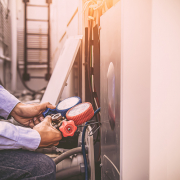How to Save Money on Commercial Heating & Cooling
Commercial Heating, Ventilation, and Air Conditioning (HVAC) systems are critical when it comes to ensuring all employees, customers, or patients remain comfortable.
But accomplishing this is no easy task – especially when your HVAC has to work even harder to maintain facility temperatures amid the heat of summer and cold of winter. More so than in homes and residential buildings, it can be difficult (and costly) to keep larger commercial buildings or spaces comfortable without racking up large electricity bills.
In fact, commercial HVAC systems account for 51% of a building’s energy usage, according to the U.S. Energy Information Administration.
Not only is an energy-efficient HVAC better for the environment, but it is a sure way to reduce electricity costs.
In this blog, we provide a list of steps commercial facilities can take to make sure their heating and cooling system is operating at maximum efficiency.
HVAC Cost-Saving Tips For Commercial Facilities
Evaluate Current HVAC Efficiency
The first step: assess the current performance of your HVAC system.
While it’s possible to measure the efficiency of residential heating and cooling systems with simple temperature readings and run-time checks, it’s not quite so simple when evaluating a large commercial building or space.
The best way for commercial facilities to check current HVAC performance is to hire a professional technician to conduct an HVAC Energy Audit.
During an HVAC audit, a technician will gather lots of data about your system’s operations – from utility bills, maintenance records, occupancy patterns, accounting documents, and a facility walk-through.
After collecting all the necessary data, the technician will conduct an in-depth analysis of your energy usage, do some calculations, and provide a status report with suggestions for improvement.
Adjust Thermostat Settings
The closer you keep the temperature on your thermostat to the outdoor temperature, the more you will save on electricity. According to the U.S. Department of Energy & Environment, you can save up to 3% for each degree the thermostat is raised in summer and lowered in winter.
The DOEE recommends the following temperature ranges:
- During summer, set the thermostat to 78 degrees when the building is occupied and 85 degrees (or even turn it completely off) after business hours.
- During winter, set the thermostat to 68 degrees when the building is occupied and between 60-65 degrees (or off) after business hours.
It’s also a good idea to set temperature zones with designated room thermostats. If certain rooms in your commercial facility – like garages, storage rooms, or unoccupied rooms – could bear to be slightly less comfortable, set the thermostat a little closer to the outside temperatures in those spaces.
You also may want to invest in programmable smart thermostats. With remote scheduling capabilities, these thermostats ensure the temperature is always set appropriately – even if you are not physically in the building.
BONUS TIP: Try to run your AC earlier in the day in warm summer months to avoid the higher costs of peak demand in the heat of the afternoon.
Keep Up With HVAC Maintenance
If your heating and cooling system is not operating efficiently, that could very well mean your HVAC has a mechanical issue or hasn’t received the regular maintenance it requires to function properly.
Some steps you’ll definitely need to take:
- Swap out air filters routinely
- Check seals & insulation regularly
- Replace the outdated boilers
- Stay on top of repairs
Remember, it is generally more expensive to make a major HVAC system repair or replacement than to hire commercial heating and cooling professionals for routine maintenance.
Upgrade to Green
As would be expected, HVACs become less and less efficient as they age.
Whether you need to replace particular parts (like your boiler or heat pumps) or your entire HVAC system, you’ll want to seek out energy-efficient upgrades.
If replacing an outdated heating and cooling system, look for a model with Energy Star certification. The Energy Star designation means that the model follows the efficiency guidelines set by the Environmental Protection Agency. These newer energy-efficient HVAC systems are uniquely designed to minimize environmental impacts and keep your energy bills low.
Take Advantage of Government Incentives
As if the energy efficiency of green HVAC upgrades isn’t enough in and of itself, the U.S. government – and even certain local governments and energy companies – offer enticing incentives and programs to encourage these green upgrades.
For example, the U.S. Department of Energy offers a tax deduction of up to $1.80 per square foot for certain buildings that save at least 50% of the heating and cooling energy.
Need help finding all the federal and local incentives that apply to you?
KFM 24/7 | Commercial HVAC Services
Balancing comfortable heating and cooling with manageable commercial utility bills can be a challenge for any business owner. But if you follow the 5 simple steps listed in this article, you will be well on your way to significant HVAC cost savings!
Need HVAC repair, replacement, or maintenance? KFM 24/7 offers these services and more to commercial facilities all across the country.
Have multiple locations under one brand? We can manage the HVAC needs of each and every location. No hassle. No stress.
Contact us today to start saving!
Read More:
- The Benefits of Outsourcing Facility Maintenance Services
- What is Facility Maintenance? And Who Needs It?
- Efficient Facility Maintenance: Tips For a Safer, More Productive Workplace



